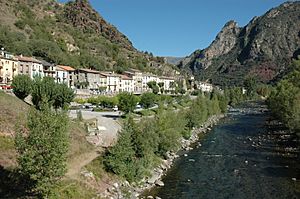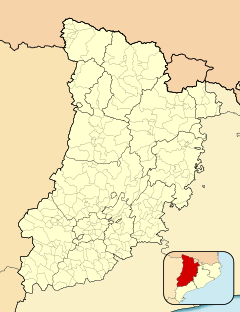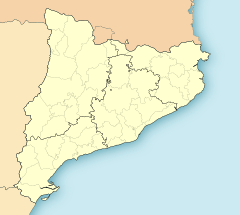Gerri de la Sal facts for kids
Quick facts for kids
Gerri de la Sal
|
|
|---|---|
|
Locality
|
|
 |
|
| Country | |
| Community | |
| Province | Lleida |
| Municipality | Baix Pallars |
| Elevation | 589 m (1,932 ft) |
| Population | |
| • Total | 117 |
Gerri de la Sal is a small village located in the Province of Lleida in Catalonia, Spain. It is part of the Baix Pallars municipality. In 2020, about 117 people lived there. This village is famous for its long history of producing salt. The name "de la Sal" actually means "of the Salt" in Catalan, which tells you a lot about its past!
Contents
Where is Gerri de la Sal?
Gerri de la Sal is found in the Pyrenees mountains. It is about 119 kilometers (74 miles) north-northeast of Lleida, a larger city. The village sits next to the Noguera Pallaresa river. This river flows through a narrow valley, making the area very scenic.
The History of Salt
For hundreds of years, Gerri de la Sal was a very important place. This was because of its salt production. Salt was a valuable resource in the past. People used it to preserve food before refrigerators existed. They also used it for cooking and trading.
How Salt Was Made
The salt in Gerri de la Sal comes from a special natural spring. This spring brings salty water from deep underground. The villagers built special flat pools called salt pans. They would fill these pans with the salty water. The sun would then evaporate the water, leaving behind pure salt crystals. This process was done by hand for many centuries.
Salt and the Monastery
The salt trade made Gerri de la Sal quite wealthy. A famous monastery, the Monastery of Santa Maria de Gerri, was built here. This monastery was very powerful in the Middle Ages. It controlled the salt production and trade. The monks played a big role in the village's economy and history. They helped manage the salt works and transport the salt to other regions.
What to See Today
Even though salt production has changed, you can still see the old salt pans in Gerri de la Sal. They are a reminder of the village's unique past. The Monastery of Santa Maria de Gerri is also still standing. It is a beautiful example of Romanesque architecture. Visitors can explore the monastery and learn about its history. The village offers a glimpse into how people lived and worked in the past.
See also
 In Spanish: Gerri de la Sal para niños
In Spanish: Gerri de la Sal para niños




